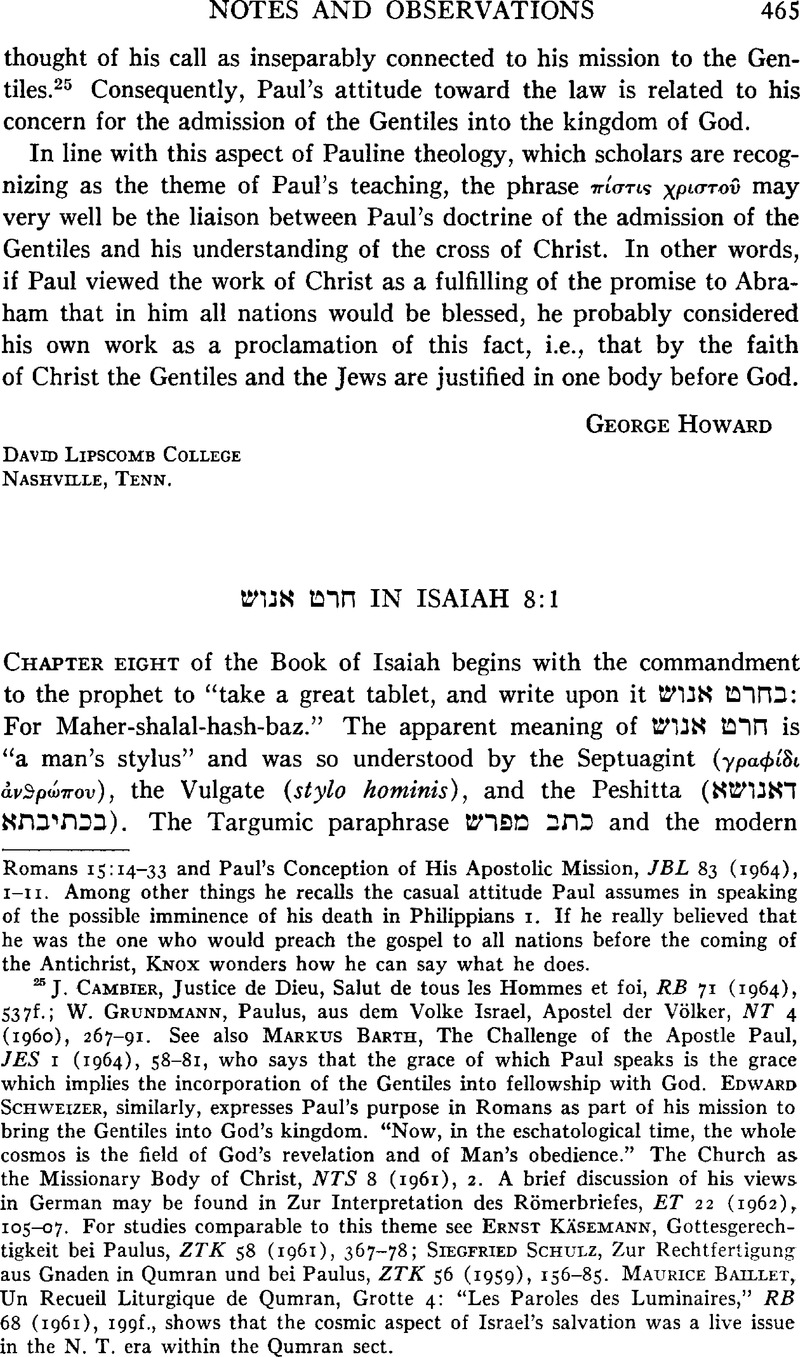No CrossRef data available.
Article contents
שונא םרח in Isaiah 8:1
Published online by Cambridge University Press: 10 June 2011
Abstract

- Type
- Notes and Observations
- Information
- Copyright
- Copyright © President and Fellows of Harvard College 1967
References
1 Cf. Ehrlich, A. B., Randglossen zur hebräischen Bibel (Leipzig, 1912), IV, 31Google Scholar.
2 Comm. to Isaiah, 8.1.
3 Meḥqarim (Tel Aviv, 1938), I, 35f.
4 Stade, B., ZAW 26 (1906), 135fGoogle Scholar.; Benzinger, I., Heb. Arch. (2nd ed.), 184Google Scholar; Gray, G. B., Crit. and Exeg. Comm. (New York, 1912), 142fGoogle Scholar.; Procksch, O., Der hebräischer Schreiber und sein Buch, in Abb, G., Von Büchern und Bibliotheken (Berlin, 1928), 10Google Scholar. For a refutation of this theory, see Galling, K., ZDPV 56 (1933), 216Google Scholar.
5 Kaufmann, Y., Toldot ha-emunah ha-yisra'elit, IV, 210, n.64.Google Scholar
6 It may be noted that Targum Jonathan translated םיםרח at 2 Kings 5:23 by ויםרלפ, a word used for translating זידמ (cf. Kimhi a.l.). םיטירח at Isa. 3:22 is translated by איכחם, the word used by Onkelos for rendering זמזכ, a type of ornament (Ex. 35:22, Num. 31:50). The Arukh (s.v. קנרב), however, brings a variant איטחמ “needles” in agreement with the Vulgate acus. This latter rendition would support Kaufmann's interpretation. טירח might have been understood by the translators to be a garment produced or embroidered by a needle (טרח). On the other hand, while Onkelos translated טרח at Ex. 32:4 by אמוז, a tool of engraving, Targum Yerushalmi II used אפישוש (cloak) which was used by Jonathan at Isa. 3:22 for חופטעמ.
7 Cf. the Eighteen Benedictions, הניב שונאל רמלמו חעד םראל ןנוח החא.
8 Cf. Ehrlich, A. B., Randglossen, IV, 31f.Google Scholar
9 Cf. Gressmann, H., Der Messias (Göttingen, 1929), 239Google Scholar, n.l. Gressmann, without documentation, renders “ein harter Griffel.” Apparently, he transferred the word “hard” from the sense expressed in the phrase ”a hard (severe) illness (ānuš)” to that expressed in the phrase “a hard metal.” Similarly, Galling transfers the sense “incurable” to script with the meaning of inextinguishable, i.e., permanent. Cf. ZDPV 56(1933), 217Google Scholar.
10 Von Soden, Akkadisches Handwörterbuch, s.v. enēšu; Gelb, I. J. et al. , The Assyrian Dictionary, s.v. enēšu, enšu; Lisān el-Ἁrab, s.v. 'n t; Diwan el-Hudhuliyyin (Cairo, 1947), II, 223Google Scholar.
11 The word חונוילג appears in the catalog of garments in the third chapter of Isaiah, which would lead one to believe that the ןוילג was made of a soft, flexible material. According to K. Galling, Biblisches Realkxicon (1937), 463, the ןוילג was indeed a sheet of papyrus.


